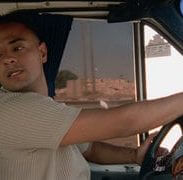
https://www.filmplatform.net/product/ford-transit
Rajai, a Palestinian “service” taxi driver ferries his passengers between East Jerusalem and Ramallah for 3 shekels a ride. En route, he either gives you insight into the daily challenges faced by Palestinians under Israeli occupation, or he drives you crazy. Or both. His take on the Intifada, suicide bombings and life in general is mirrored in his passengers—which include prominent Palestinian political and cultural figures, and more than one delightful cameo appearance in this blurry document of fact and fiction.

When I started to think about the concept for Ford Transit, I wanted to make a film very close to daily life reality. Living under occupation is an adventure. Very surreal, like feeling you need to be Indiana Jones to go to your work. This is the common existence of Palestinians nowadays. Full of confusion; all the time you ask yourself; is this real or are we living in a film? I came to the conclusion that, if I wanted to make an audience experience this confusion, I must combine reality with created reality in every scene. I wanted the audience to feel it is all real, but that it also can be staged. They are looking at a film, not a report, though it is still reality. This is in conflict with classic definition of a documentary: You don’t dictate reality. In fiction you do, to create a story. But I wanted both, at the same time.
I created confusion by, for example, interviewing Hanan Ashrawi in a clearly staged situation, the Ford Transit taxi, which she would never use. If the stage couldn’t be dictated, then sometimes I dictated characters. For this reason I asked a crewmember, the runner and driver of my previous feature film, Rajai Khatib, to become a real driver of the Ford Transit taxi.
The only locally professional, famous actor in my film is Basam Zomot, the man who wanted to forbid Bush appearing unwarned on the television. I interviewed him like any regular person, in order to create confusion for the local audience: What is he doing there? Is he there by accident or is doing what the director wants?
During the filming of slow motion images, by chance, and from afar we filmed a soldier hitting a Ford Transit driver, not ours. We asked that driver why he had been beaten. He told us that the soldier asked him what his name was and that he had answered that it was written down in the papers the soldier was holding. ‘Don’t try to be smart’, the soldier said, ‘when I ask a question, you just answer’. The soldier confirmed this story to us. I used the slow motion take of the hit with the music of Dr Dre under it. It became an enjoyable image and not a painful one. I reused this scene, but this time it was our driver Rajai, himself being hit. With it I reused the dialogue from the Polish feature film Ashes and Diamonds. Now, using the documentary language, the image became painful.
This proved to me it is not the facts that matter, it is the way you show them that matters. It is interesting for me to play with this concept. It is an integrated concept as I combined reality with dictated reality. Using the quality of Super 16 the images becomes alive and real, but also close to feature film.
Besides creating confusion it is also important to be drawn into the film, identify with the characters and the situation they are in. I rebuilt famous dialogues from feature films not only to increase confusion but also to allow identification with the characters, in this case Rajai. Even if you don’t recognize the dialogue’s I used, they can still be identified as feature film dialogues by the sound of them.
What I did is using reality to tell a story and I created reality to experience daily life in Palestine. This makes it a 100% documentary, but at the same time it is 100 % fiction. I didn’t obey journalistic rules, but never abused reality. I dictated reality to tell a story about daily life reality.
As everything has to be categorized, we decided to attach the name documentary to Ford Transit, because of the cinematographic language and the context: The camera is visible and all things that happened happen in real. It happened accidental in front of the camera or my own eyes, and I recreated it later. Using the music of Morriconi, the icon of the Spaghetti Western, a kind of fake western, combined with the slow motion images of the West Bank, the Wild West became the Wild West Bank.
I solved the ethical dilemma of the classical documentary definition because I never made up situations. Nowadays the definition of documentary is released from the myth that you don’t change reality in documentary. We all know that as soon as you arrive with a camera you change the course of things. When you use music you influence the mood, and in the editing room you change context and timing. I state that a documentary is a documentary when you don’t lie about the situation.
Hany Abu-Assad